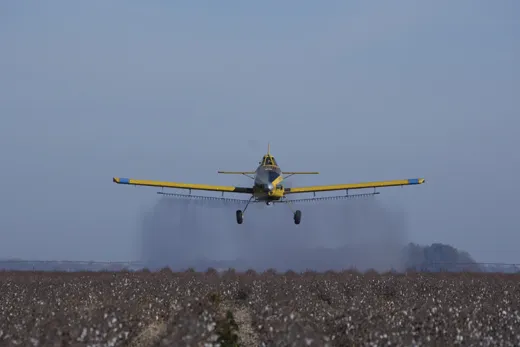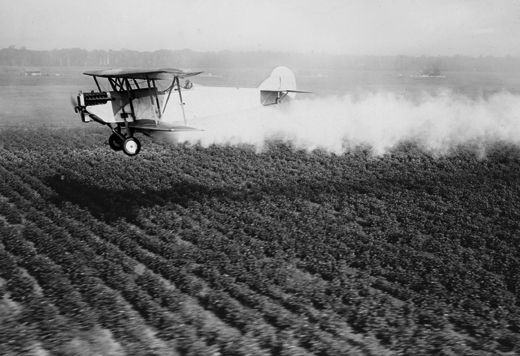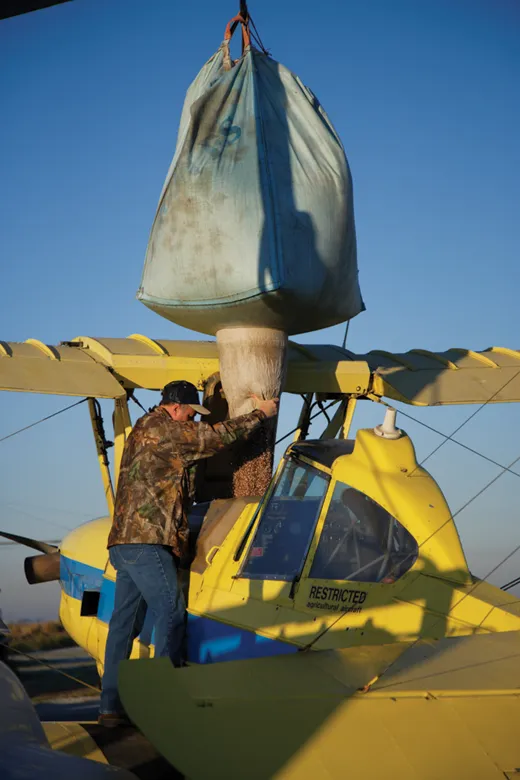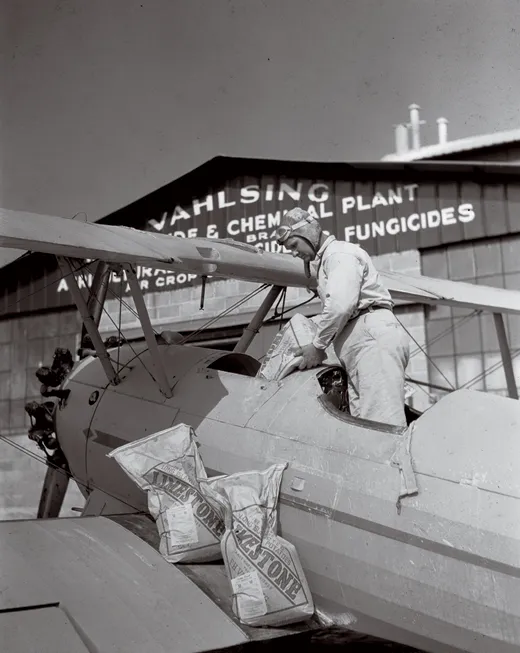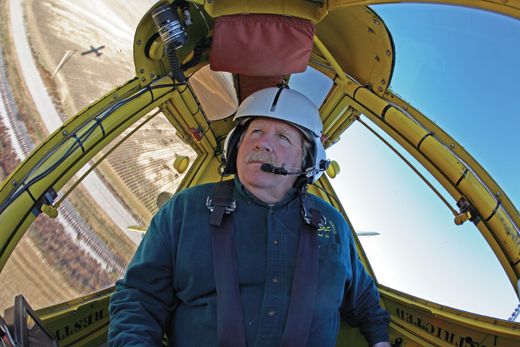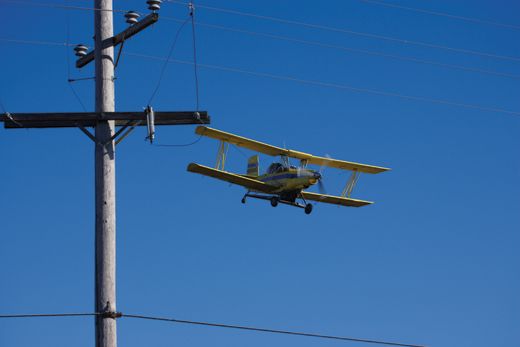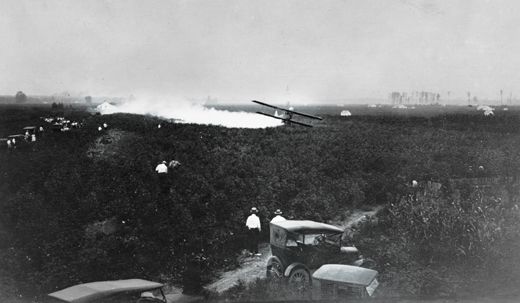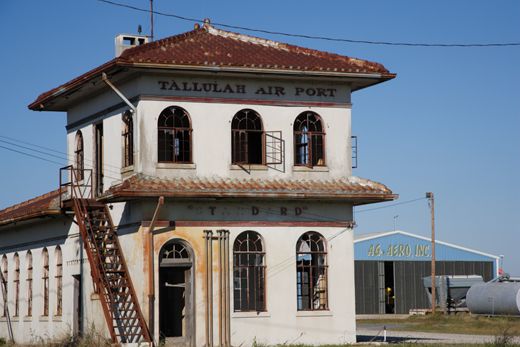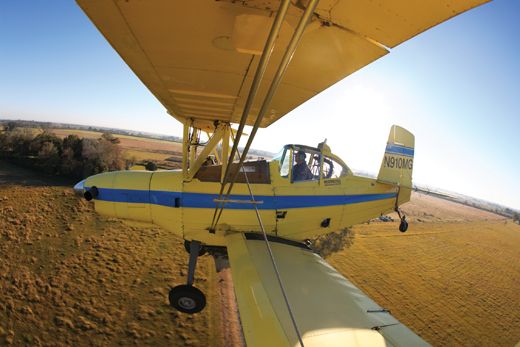That Old-Time Profession
The airplanes are faster and the power lines more plentiful, but cropdusters fly today just as they did in the 1920s.
We are tearing along at 120 mph about six feet above the ground in Mark Edwards’ Citabria. Ripe cotton brushes the landing gear, and the field is a dirty white blur. “You want leaves in your brake calipers when you land,” Edwards says matter-of-factly on my headset. The Mississippi cotton field is bordered by dirt roads and outlined with rows of trees, fences, and more power lines and utility poles than I’ve noticed anywhere before. Silos, sheds, and barns jut ominously. When you’re looking for potential obstructions, cell phone towers and radio antennas held erect with nearly invisible guy wires seem to multiply.
Edwards, an agricultural pilot with 16,000 hours, calls my attention to the power lines that cut across the field about a quarter of a mile ahead. We’re closing in on them at roughly 200 feet per second. This is like “slow mo,” he says, compared with his turbine-powered Air Tractor, which he flies all day long at 140 mph. But the Air Tractor doesn’t have a passenger seat, so he’s using his two-place Citabria to approximate for me what cropdusting is like.
As we pass under the wires, I duck and curse reflexively. “Make you duck?” Edwards asks. “I do sometimes.” He pulls up short of some trees, points the nose at the oyster-shell sky, then rolls the airplane over on its left wing and dives back down at the cotton field. He levels out, seemingly inches above the ground, and does the power line limbo again. “You gotta stay composed doing that,” he says. “Real hot days the wires stretch and droop. Ones you fit under before can go lower.” He makes another turn, then says, “You get bird strikes around power lines. They spook at the last second.”
Aerial application, as cropdusters like to call their trade, is barely aerial. The lower the airplane flies, the smaller the chance the chemicals it disperses will drift away from the target crops and the greater the chance the target will be covered evenly. Mark Brown, an ag pilot in central Washington, says he flies 10 or 12 feet above the ground “so the product mixes in our airflow instead of individual streaks hitting the ground. Too high, you get drift.
Fifteen feet can be too high. You take what the wind offers.”
Short of combat flying, there probably isn’t a more demanding mission for pilots and aircraft than spraying crops. I’ve heard stories of ducks flying up into airplanes from Louisiana rice paddies, horses that suddenly stand from a slumber in tall Mississippi cotton, fence posts that appear in inconvenient locations, and any number of mishaps, mid-airs, near-misses, and forced landings.
A 2002 Federal Aviation Administration report noted that the accident rate for agricultural operations is higher than the overall accident rate for general aviation, yet the fatality rate is lower. Ag pilots and the makers of the airplanes they fly have learned to manage a workplace crowded with things to run into. Safety features include wire cutters in front of the windscreen to keep a pilot who has run into a power line from being decapitated. Cockpits have strong harness systems, collapsible structure in front of the pilot, low-positioned instrument panels, and an energy-absorbing seat. But ag planes didn’t start out that way.
The Edwards brothers, Mark and Bubba, grew up on a farm less than a mile from their fixed-base operation, Edwards Flying Service, which comprises two hangars, tanks, sheds, a 3,400-foot runway, and a concrete pad, where they mix and load chemicals. They are hefty, pleasant, unflappable pilots who rarely fly above 500 feet or more than a few miles from their strip. They aren’t instrument-rated and don’t want to be, and they can’t imagine wanting to do any less challenging kind of flying. Like all ag pilots, they avoid obstacles (or not) all day while precisely spraying dozens of 3,000-pound loads of expensive chemicals, seeds, and fertilizers from airplanes that are designed to withstand 50 or more takeoffs and landings and a couple of hundred tight, fast turns a day, day after day.
From a dirt strip next to the Edwards’ farmhouse, John “Bubba” Edwards Sr. flew a war-surplus Stearman with a 55-gallon drum strapped in the back seat that was plumbed to spray crops. The brothers went to a cropdusting school because Bubba Sr. was self-taught and didn’t feel he’d be a good instructor, but they grew into ag aviation under his tutelage. “Daddy’d watch us fly neighbors’ fields and talk to us afterwards,” Mark recalls. “He’d tell us things like: ‘Drive around every new field and look for wires before you fly it’ or ‘Put the throttle to the firewall. Those planes can take it’ or ‘Look way out ahead; don’t get stuck staring.’ We grew up living and talking flying.”
On any given summer morning across the country in the postwar years there would be as many as a thousand Stearman cropdusters in the air. Stearmans served as primary trainers for the U.S. Army and Navy and the Royal Canadian Air Force, and by the end of World War II more than 10,000 had been built. The ones that survived their student pilots were sold as war surplus for as little as $250. For a generation, they were the standard of the industry, and a handful still fly. The Stearman didn’t have an energy-absorbing seat, but it was stable and friendly and allowed new pilots or low-flying cropdusters to fly out of most of the mistakes they could make. A Stearman A75 equipped with a 450-horsepower Pratt & Whitney engine occupies a place of honor at the National Agricultural Aviation Museum in Jackson, Mississippi.
Cotton dusting around Leland, where the Edwards brothers work today, was already a tradition when the war-surplus Stearmans showed up. By 1930, farmers in the Mississippi Delta were learning about aerial experiments conducted by the U.S. Department of Agriculture’s Delta Laboratory in Tallulah, Louisiana. The laboratory was a sworn enemy of the boll weevil, which was causing millions of dollars’ worth of cotton losses annually, and its director, entomologist Bert Coad, was fascinated by airplanes. (So was his assistant, C.E. Woolman. Woolman later founded a dusting operation, Delta Flying Service, which eventually became Delta Air Lines.) Coad had been impressed by the 1921 flights of Army Captain John Macready, who spread lead arsenate on a grove of moth-infested catalpa trees near McCook Field in Ohio from a war-surplus Curtiss JN-6H Jenny. Until then, cropdusting had been a laborious and brutal process. Macready accomplished in 54 seconds what would have taken two men with a wagon and a team of mules a week to do.
By August 1922, Coad had hired World War I veterans to fly two Jennys and a surplus de Havilland DH-4B in hundreds of test flights over delta cotton fields. The heedful young Army pilots evolved techniques to prevent chemical drift, the cropduster’s perennial hassle, which required constantly “playing” surface winds and flying low and slow. The lab added a venturi in front of the hopper to provide ram-air pressure to blow the dust out a six-foot-wide dispenser fastened under the aircraft, mercifully replacing mechanics who had been crouching in back seats, operating the hoppers with a hand crank.
In 1923, George Post, pilot and vice president of the Huff-Daland Aircraft company, also learned of the test flying the U.S. Department of Agriculture laboratory was conducting. Two years later, Huff-Daland had redesigned its Petrel 5 airplane and had begun building the Huff-Daland Duster, a fabric-covered biplane powered by the 200-horsepower Wright J-4 Whirlwind radial.
Other manufacturers saw the potential in ag aviation after the war, and in the 1950s and ’60s four new airplane types would dominate it: Grumman Ag-Cats, Piper Pawnees, Rockwell-Standard Commander Thrushes, designed by Leland Snow, and Snow’s Air Tractors. These would become the basis of the multimillion-dollar, 3,500-airplane industry cropdusting has become today. Snow, 77, has seen more than 2,000 Air Tractors alone roll out of his facility in Olney, Texas, since he started manufacturing them in 1958.
For more than 55 of the 85 years of cropdusting history, Leland Snow has been the major contributor to the development of “flying farm equipment,” as he calls his airplanes. Snow’s designs, which inspired other ag plane makers, incorporated a tubular steel framework that includes a roll cage to protect pilots in mishaps.
Former rice pilot Don Waguespack, whose career spanned the gamut from Stearmans to GPS-equipped turbines, knows first-hand how important cockpit protection can be. By the time he retired, at 66, “Wag,” as he is known throughout Louisiana rice country, had become a legend, having survived more forced landings than he can recall and walking away from three airplane wrecks. His worst, he says, was in a 450-horsepower Grumman Ag-Cat. “They had overloaded the airplane with fertilizer and didn’t tell me,” he recalls, “so after I took off, I couldn’t make it over the line of trees at the end of the runway.” The wings tore off as the Grumman shouldered through the treetops and went in head first. When the airplane hit the ground, the engine broke away and Waguespack jumped out into a pool of avgas, happy there was no electrical system in the airplane to ignite a fire. He was also happy he hadn’t been flying the Stearman, an airplane, he says, that “was not designed for that kind of work or that kind of wreck.”
Cropdusters work in a hierarchy of hazards, starting with the maze of obstacles they fly through and progressing through the farmers’ constant antagonists: time and weather. In the rice farming states—Louisiana, Mississippi, Arkansas, Texas, and California—every phase of rice production except the harvest is accomplished from the air. The most critical is planting. When the sprouted rice is ready, it must be aerially seeded in the flooded paddies within hours. “It doesn’t matter what the weather’s doing, the farmers have a small fortune tied up in the sprouts and we have to get it planted,” says pilot Butch Dehart. A muscular 45-year-old, Dehart grew up on a farm a couple miles from Ken Guidry’s Victory Flyers, near Abbeville, in southwest Louisiana, where Waguespack worked for years. Dehart speaks paternalistically about “his” farmers in his corner of Vermillion Parish, most of whom he’s known all his life. “They’re spoiled,” he laughs. “They pick up the phone and know we’re going to take care of their crops.”
The worst flying and landing conditions often coincide with the rice planting season, but rice pilots can’t wait till the weather clears. When the demands of the rice season required flying on rainy days, farmers would send fuel and loader trucks to parish roads surrounding the rice farms to refill the ag planes. “We need blacktop runways because the dirt strips are just mud,” says Dehart. Parish deputies would hold traffic until the pilots could land, fill up, and take off again, but for the last few years, Dehart explains with a hint of rancor, it’s up to the pilots and farmers to block roads so they can land for refueling and reloading their hoppers.
When ag plane builders started equipping their products with turbine engines, the cropdusting life got easier. Victory Flyers owner Ken Guidry, who was a cropduster for 46 years, since he was 19, modified his fleet with turbines in the 1980s, and at one time owned five turbine Ag-Cats. “I never dreamed anyone would have that much, let alone me,” he says today. “Everything got faster, safer, more fun, and paid better,” recalls Waguespack.
“One turbine-powered spray plane can do more than twice what a radial-engined plane could.
“When you’re turning, you ain’t earning,” Waguespack continues. “You make your pass, close your hopper, and your first move is downwind, nose up, to bleed off speed.” I ask him if that’s called a “P” turn or a “hammerhead.” He shrugs and says: “I call it the get-back-down-on-the field-as-fast-as-you-can turn.” Cropdusters repeat that pattern hundreds of times a day, between landings and takeoffs every 10 minutes or less to refill the hopper.
The public feels a sort of general unease about the chemicals the ag pilots spread. GPS has improved the precision and efficiency of spraying, but chemicals can still drift, and the practice of cropdusting has grown controversial. “People waved to us 30 years ago,” says Waguespack. “Now we look out for guys with shotguns.” To avoid drift, Louisiana pilots ground themselves when winds exceed 10 mph. “Dust devils or strong gusts crossing over trees could throw you out of the plane if you weren’t strapped in,” Waguespack claims. “It only throws you around for a second or two, but at 30 feet of altitude that can spoil your day.”
The winds that pitch and plunge, often unpredictably, out of Washington state’s 10,000-foot Cascade Mountains are day spoilers for northwestern ag pilots. The Quincy Flying Service’s hangars and paved strip reside in the lee of the Cascade foothills. In central Washington, where the foothills finally flatten out, hardened volcanic flows intrude through thin soil and make farming difficult. The farmers manage with the help of irrigation pivots, watering booms that look like fallen radio towers mounted on tractor tires. Center-pivot irrigation fixtures have turned Grant County into the “second biggest potato-producing county in the U.S.,” signs on Highway 2 brag.
Two dachshunds, a terrier, and Rick Weaver, flying service owner and pilot, greet visitors at the hangar office. Weaver employs two pilots to do the spraying: Mark Brown, 38, and Dave Mickelson, 48. Over the years, the Weavers have owned six Pawnees, two helicopters, and an assortment of smaller “recip planes,” which they have now replaced with turbine-powered Air Tractors.
The Columbia River defines the western edge of Grant County, and two-inch-thick cross-country power lines, carried in sets of eight by towers 12 stories tall, radiate from the many hydroelectric dams like strands in an enormous metal web. Fiber-optic lines have been hung beneath the power lines. More wires to new irrigation pivots and commuter ranchettes show up every year, in addition to the hundreds of phone and electric lines that serve crossroads communities and farms. Grant County looks to be embroidered with more wires per square mile than any place in the United States.
Among Grant County ag pilots, a conventional wisdom has developed about how to survive wire strikes. Mickelson’s advice: “You can’t break a cross-country wire with your landing gear, so hit the wire square with your prop, so you cut it,” which Mickelson did, just seconds before totaling an Air Tractor a few years ago. “I was looking at the wires a couple hundred feet ahead and forgot about the one right in front of me,” he says. “I got my prop into it and cut it. I swapped some airspeed for maybe a hundred feet of altitude. My windscreen was covered with oil, but out the side I saw a chance to clear a hundred-foot-tall poplar windbreak and land uphill in an apple orchard between the rows.” From the moment he hit the wire until he climbed from the wreckage, perhaps a minute elapsed.
Like a lot of cropdusters, the Quincy pilots talk about ag flying as though it were motocross riding or extreme skiing, where the speed and time in the air and the split-second decisions and the equipment they’re riding are always manageable if not exactly under control.
Perhaps the most perilous job in ag aviation is the night spraying that Gary Hubler, near Boise, has done for most of 31 seasons. Seed crops such as alfalfa in Idaho’s Treasure Valley must be pollinated by bees. Hundreds of beehives are trucked into the valley for the seasonal job. Insecticides sprayed during the day would kill the bees, so the crop sprayers work at night, after the bees have made it back to the hives. About 30 percent of his flying time, Hubler takes to the night skies. He shrugs off the danger. “You develop night vision,” he says. “But when you’re going under power lines and over trees, a good memory of where the obstructions are from seeing the field in daylight helps a lot. It’s usually smooth; the winds die down at night.” Hubler, 52, is tall and slim with a rolling stride. He flies Polish-built Dromader M-18As, a monoplane design derived from Leland Snow’s S-2.
Hubler’s father was a cropduster for 21 years. His brother Dan, also a cropduster, died in 1986 when he clipped a power line while he was spraying at dusk, a mishap, as Hubler explains it, that Dan had avoided “a million times.” Hubler shakes his head slowly. “For a while I flew freight, and didn’t know if I’d go back to the job that killed my little brother.”
Ag pilots don’t grow on trees. Many in the profession are retiring, and there are only a handful of schools around the country to instruct new pilots. One of them, Ag Flight in Bainbridge, Georgia, graduates as many as 40 students a year, but they can become ag pilots only after established operators bring them up through the ranks, sometimes starting them off as loaders or other ground-crew positions. The fine points of cropdusting continue to be passed along, for the most part, by word of mouth, just as John Edwards instructed his sons how to spray cotton around Leland, Mississippi. And because a turbine-powered ag plane can cost well over half a million dollars, insurance companies often request a training syllabus from operators before insuring the aircraft. “You have to be real persistent to break into ag aviation,” according to Jerry Miller, an instructor at Ag Flight.
In that way, the profession hasn’t changed so much. It was tough to break into the business when Don Waguespack was trying in the early 1950s. “I always had the urge to fly, since I was about 12,” he says. “I wanted to learn but I didn’t know how I would go about doing it.” He got a job loading trucks for the air service that sprayed his father’s rice farm, and with a loan from his uncle, he bought a Piper Cub Special and got his pilot’s license. “Then the owner of the air service gave me the chance to fly,” he says. “Flying low like that—it was exactly what I imagined.” Ken Guidry had a similar experience: “I started with nothing, and I made a lot of money, and it was fun,” he says. “It never seemed like a day’s work.”
For the determined, Jerry Miller believes, there are jobs today. “I hear every day about some operator who needs to replace a retiring pilot,” Miller says. “Fifteen years ago there were no job openings. Today a new pilot can earn 90 dollars per hour spraying boll weevil in the southeast. I don’t know about other regions and crops, but the jobs are out there.” He pauses, then adds, “When they quit building John Deere tractors, they can quit building ag planes.”
When I asked Gary Hubler about retirement, and if he could sell his business, he said, “I’d have to get a cheap plane and break a young guy in like my Dad did me. Get his hours built up, watch him fly, and talk to him about all the ways to avoid getting hurt. Eventually he’d be coming out of a turn, in the dark, checking the GPS, while shooting an approach back down to the field under a power line, and exactly when and where he needs to, he’d open the old ‘money handle’ and put the spray exactly where it has to go and then he’d know he had arrived and I’d be happy and so would some farmers.”
Kenneth Trahan, a fifth-generation Louisiana rice farmer, put it this way: “Thank goodness there’s a few pilots brave enough to do it. We can’t grow rice without ’em.”
